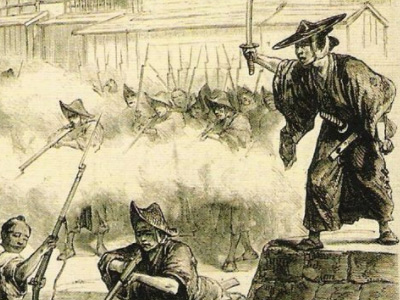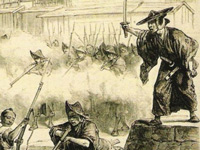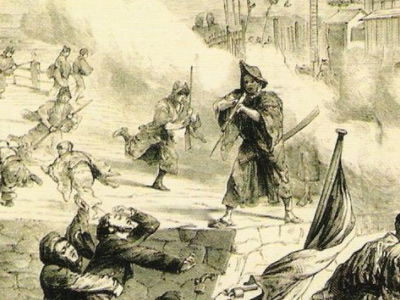Boshin War (1868-1869)

Coups d'état
Following a coup within Chōshū which returned to power the extremist factions opposed to the Shogunate, the Shogunate announced its intention to lead a Second Chōshū expedition to punish the renegade domain. This in turn prompted Chōshū to form a secret alliance with Satsuma. In the summer of 1866, the Shogunate was defeated by Chōshū, leading to a considerable loss of authority. In late 1866, however, first Shogun Iemochi and then Emperor Kōmei died, respectively succeeded by Yoshinobu and Emperor Meiji. These events, in the words of historian Marius Jansen, "made a truce inevitable".
On November 9, 1867, a secret order was created by Satsuma and Chōshū in the name of Emperor Meiji commanding the "slaughtering of the traitorous subject Yoshinobu". Just prior to this however, and following a proposal from the daimyō of Tosa, Yoshinobu resigned his post and authorities to the emperor, agreeing to "be the instrument for carrying out" imperial orders. The Tokugawa Shogunate had ended.
While Yoshinobu's resignation had created a nominal void at the highest level of government, his apparatus of state continued to exist. Moreover, the shogunal government, the Tokugawa family in particular, would remain a prominent force in the evolving political order and would retain many executive powers, a prospect hard-liners from Satsuma and Chōshū found intolerable. Events came to a head on January 3, 1868 when these elements seized the imperial palace in Kyoto, and the following day had the fifteen-year-old Emperor Meiji declare his own restoration to full power. Although the majority of the imperial consultative assembly was happy with the formal declaration of direct rule by the court and tended to support a continued collaboration with the Tokugawa (under the concept of "just government" (公議政体 kōgiseitai)), Saigō Takamori threatened the assembly into abolishing the title "shogun" and ordering the confiscation of Yoshinobu's lands.
Although he initially agreed to these demands, on January 17, 1868, Yoshinobu declared that he would not be bound by the Restoration proclamation and called for its rescission. On January 24, he decided to prepare an attack on Kyoto, occupied by Satsuma and Chōshū forces. This decision was prompted by his learning of a series of arsons in Edo, starting with the burning of the outerworks of Edo Castle, the main Tokugawa residence. This was blamed on Satsuma rōnin, who on that day attacked a government office. The next day shogunate forces responded by attacking the Edo residence of the daimyō of Satsuma, where many opponents of the shogunate, under Takamori's direction, had been hiding and creating trouble. The palace was burned down, and many opponents killed or later executed.
HISTORY

RESOURCES
This article uses material from the Wikipedia article "Boshin War (1868-1869)", which is released under the Creative Commons Attribution-Share-Alike License 3.0.
© Stories Preschool. All Rights Reserved.









